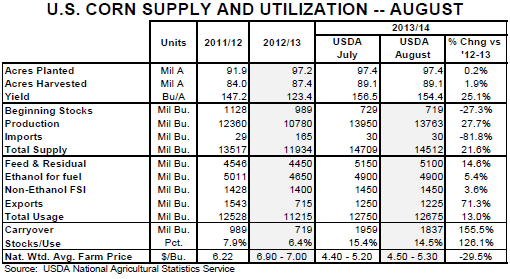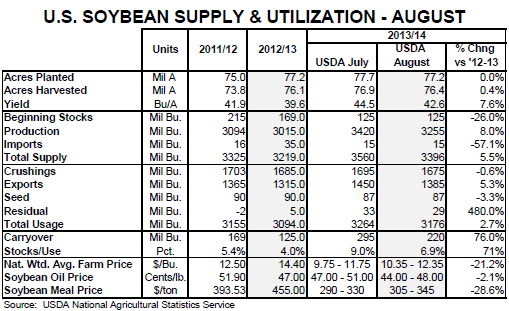

Some highlights of the report are:
• No changes for corn acres from their July report levels of 97.4 million acres planted and 89.1 million acres harvested. This is not a big surprise but there was some thinking that the numbers might be reduced due to major planting delays in the NE Iowa-SE Minnesota- SW Wisconsin area.
• USDA forecast the corn yield at 154.4 bushels per acre. That is 2.1 bushels lower than the July estimate and 3.3 bushels lower than the average pre-report estimate. In fact, it is just barely larger than the low end of the pre-report estimate range.
• The lower yield put total corn production at a record-large 13.763 billion bushels, down 187 million from July but still 28 per cent larger than last year crop.
• USDA reduced estimated feed/residual usage by 50 million bushels. That is a good move in our opinion that may have to be made again in future months since the figure is still 14.6 per cent larger than last year. While wheat feed usage is estimated to be 110 million bushels lower in the coming year, the total feed/residual usage for corn, wheat, sorghum, barley and oats is still 10 per cent higher than this past year. While chicken and hog numbers and weights will grow, cattle numbers will be lower and, depending on the outcome of the Zilmax/beta-agonist situation, weights may decline as well. We think it will be difficult to actually use 5.1 billion bushels of corn for feed in 2013-14.
• 2012-13 corn carryout stocks were reduced to 719 million bushels from 729 million in July due to a 5 million bushel increase in imports and a 15 million increase in exports. This change plus the changes in output and usage for the coming year puts projected 2014 year-end stocks at 1.837 billion bushels or 14.5 per cent of projected total usage. This would be the highest year-end stocks/use ratio since 2005 (see chart at right). The 14.5 ratio is also pretty comparable to those of 2007-2009, years that saw corn prices near and even below $4.00 per bushel.
• USDA shaved 500,000 acres off of both the planted and harvested acres estimate for soybeans, reflecting acreage reduction in Kansas (200k), South Dakota (100k), North Carolina (100k), Minnesota (90k) and Arkansas (50k).
• The national average soybean yield was pegged at 42.6 bushels per acre, nearly 2 bushels lower then the July estimate and about 1 bushel lower than the average pre-report trade estimate. The national average includes projected record yields in Michigan, Ohio, Pennsylvania and New York. Dr Darrell Good of the University of Illinois observed that the forecast 47 bushels per acre in Illinois looks a little low given the conditions there so far while the projected 46 bushels per acre in Iowa looks a little high. We would concur on both points.
• The total soybean crop is pegged at 3.255 billion bushels, the third highest on record. USDA dropped forecast crushings by 20 million bushels and 2013-14 exports by 65 million bushels in this report versus July.
• The lower forecast output more than offset the reductions in usage, though, and forced the projected year-end carryout to 220 million bushels. That figure is down from 295 in July but represents a 76 per cent increase over this year’s expected year-end stocks of just 125 million bushels. The 2013-14 projected stocks/use ratio is 6.9 per cent, the highest for soybeans since 2006-2007.
So what will be the impact of these supplies and the prices they imply on meat and poultry sectors? We think they will provide a "greener" light for the chicken and pork sectors to expand. We say "greener" instead of green simply because there is still some significant weather risk, especially for beans. The western Cornbelt corn crop has dodged a bullet so far as temperatures have been below normal even as rainfall has be far from sufficient in many areas. And some of those areas got some rain (not enough, we hear) Monday and Monday night. Both crops are still susceptible to an early frost and we will not know if that happens until the day it doesn’t — or does — indeed occur.





